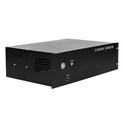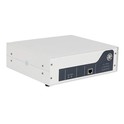As a supplier of the ResoLab - 1000 Lab Grade Ultrasonicator, I am well - versed in the installation process of this high - performance laboratory equipment. In this blog post, I will guide you through the step - by - step installation of the ResoLab - 1000 on a laboratory bench, ensuring that you can set it up correctly and start using it for your scientific experiments and research.
Pre - installation Preparations
Selecting the Right Location
The first step in installing the ResoLab - 1000 Lab Grade Ultrasonicator is to choose an appropriate location on the laboratory bench. The location should be flat, stable, and able to support the weight of the ultrasonicator. Avoid areas that are prone to vibrations from other equipment, as excessive vibrations can affect the performance of the ultrasonicator. Additionally, make sure the location is well - ventilated to prevent overheating of the device.
Checking the Power Supply
Before installing the ultrasonicator, you need to check the power supply requirements. The ResoLab - 1000 Lab Grade Ultrasonicator is designed to operate within a specific voltage and frequency range. Refer to the user manual for the exact power requirements. Ensure that the laboratory bench has a suitable electrical outlet that meets these specifications. If necessary, use a voltage stabilizer to protect the ultrasonicator from power fluctuations.
Gathering the Necessary Tools
You will need a few basic tools for the installation process. These may include a screwdriver (if required for mounting), a level to ensure the ultrasonicator is installed horizontally, and a measuring tape to check the available space on the bench. Having these tools ready beforehand will make the installation process smoother.
Unpacking the Ultrasonicator
Inspecting the Package
Carefully unpack the ResoLab - 1000 Lab Grade Ultrasonicator from its packaging. Inspect all the components for any signs of damage during shipping. Check the main unit, the probe (if applicable), the power cord, and any other accessories that come with the device. If you notice any damage, contact our customer support immediately at the earliest.
Familiarizing with the Components
Take some time to familiarize yourself with the different components of the ultrasonicator. The main unit usually contains the control panel, where you can set the operating parameters such as power, time, and pulse mode. The probe, if included, is used to deliver the ultrasonic energy to the sample. Understanding the functions of each component will help you during the installation and subsequent operation.
Mounting the Ultrasonicator on the Laboratory Bench
Determining the Mounting Method
Depending on the design of the ResoLab - 1000 Lab Grade Ultrasonicator, it may be mounted directly on the laboratory bench or on a stand. If it is a bench - top model, place the ultrasonicator on the pre - selected location on the bench. Use a level to ensure that the ultrasonicator is perfectly horizontal. This is important for the proper functioning of the device, as an uneven surface can cause the ultrasonic waves to be distributed unevenly.
Securing the Ultrasonicator
If the ultrasonicator needs to be secured to the bench, follow the instructions in the user manual. Some models may come with mounting brackets or screws. Use the appropriate tools to attach the ultrasonicator firmly to the bench. Make sure not to overtighten the screws, as this could damage the device or the bench.
Connecting the Components
Connecting the Probe (if applicable)
If your ResoLab - 1000 Lab Grade Ultrasonicator comes with a probe, carefully connect it to the main unit. Follow the connection instructions provided in the user manual. Ensure that the connection is secure to prevent any loss of ultrasonic energy during operation.
Connecting the Power Cord
Connect the power cord of the ultrasonicator to the electrical outlet. Make sure the connection is tight to avoid any electrical hazards. Do not plug in the power cord until you have completed all the other installation steps and are ready to test the device.
Testing the Ultrasonicator
Initial Power - on
Once the ultrasonicator is installed and all the components are connected, it is time to test the device. Before turning on the power, double - check all the connections and settings. Slowly turn on the power switch on the ultrasonicator. The control panel should light up, indicating that the device is receiving power.
Running a Test Cycle
Refer to the user manual to set up a simple test cycle. Start with low power and a short operating time. This will allow you to check if the ultrasonicator is functioning properly without subjecting your samples to high - intensity ultrasonic waves. Observe the device during the test cycle for any abnormal noises, vibrations, or error messages on the control panel. If you encounter any issues, turn off the power immediately and refer to the troubleshooting section of the user manual or contact our support team.
Maintenance Tips after Installation
Regular Cleaning
After installing and using the ResoLab - 1000 Lab Grade Ultrasonicator, it is important to keep it clean. Wipe the exterior of the device with a soft, dry cloth regularly to remove dust and debris. If the probe is used, clean it according to the instructions in the user manual to maintain its performance.
Calibration
Periodically calibrate the ultrasonicator to ensure accurate and consistent results. Follow the calibration procedures outlined in the user manual. Calibration helps to maintain the quality of your experimental data and the long - term performance of the device.
Other ResoLab Ultrasonicator Models
In addition to the ResoLab - 1000 Lab Grade Ultrasonicator, we also offer other models such as the ResoLab - 500 Lab Grade Ultrasonicator and the ResoLab - 2000 Lab Grade Ultrasonicator. These models have different specifications and features to meet the diverse needs of your laboratory. Whether you need a smaller, more compact ultrasonicator for basic applications or a more powerful model for advanced research, we have the right solution for you.
Conclusion
Installing the ResoLab - 1000 Lab Grade Ultrasonicator on a laboratory bench is a straightforward process if you follow the steps outlined above. By carefully preparing for the installation, unpacking and mounting the device correctly, connecting the components properly, and testing the ultrasonicator, you can ensure that it operates efficiently and provides reliable results for your laboratory work.


If you are interested in purchasing the ResoLab - 1000 Lab Grade Ultrasonicator or any of our other products, please visit our website ResoLab - 1000 Lab Grade Ultrasonicator to learn more about our products and contact us for further details. Our team of experts is always ready to assist you with your purchasing decisions and provide you with the best solutions for your laboratory needs.
References
- ResoLab - 1000 Lab Grade Ultrasonicator User Manual
- Laboratory Equipment Installation Guidelines
- Ultrasonicator Operation and Maintenance Best Practices





